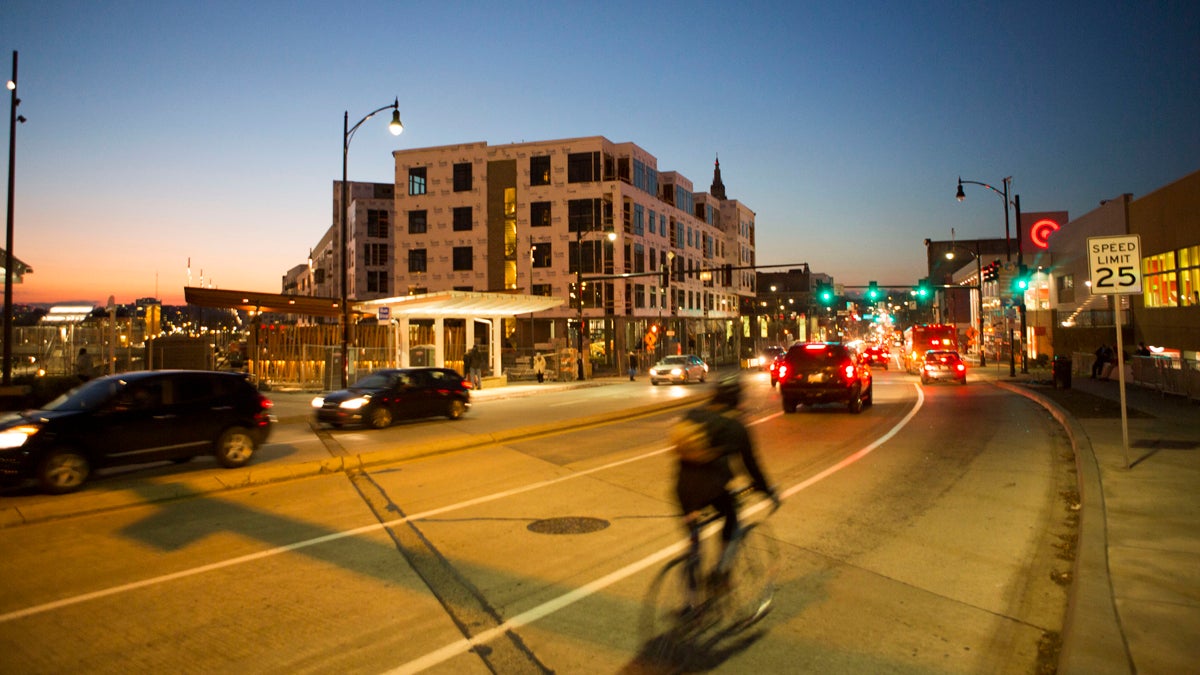What’s big for Pennsylvania cities in 2016? Help us decide.

Pittsburgh’s East Liberty neighborhood at sunset. (Photography by Jessica Kourkounis)
The Keystone Crossroads team wants your input on our 2016 coverage.
Accountability.
That, to me, is the most consistent theme among different plans and ideas for the upcoming year shared with me recently by my Keystone Crossroads colleagues.
That includes, in no particular order:
City Hall politics
It’s not a mayoral election year. But 2016 will be significant for mayors’ offices.
It’s year one for Philadelphia Mayor Jim Kenney in the commonwealth’s largest city. Same for Tony George, who’s following Wilkes-Barre’s longest-serving mayor Thomas Leighton.
Incumbent mayors were ousted in two distressed Pennsylvania cities.
New Chester Mayor Thaddeus Kirkland says he’s going to hold on to his seat in the state House of Representatives, which he’s had for 24 years, until the state budget gets straightened out.
Then there’s Reading.
Public corruption
Wally Scott takes over in Reading for Vaughn Spencer, who’s embroiled in the FBI probe of the local government there. The feds are investigating Allentown City Hall as well. (Mayor Ed Palowski’s got another two years left in his term).
We’ll follow those corruption cases and a separate one being brought by the state Attorney General’s office against former Harrisburg Mayor Stephen Reed.
The Attorney General’s office has promised additional arrests in the Harrisburg investigation, which centers on the city’s financial problems.
Municipal finance
Harrisburg’s fiscal issues were so bad that the state basically took over the municipal government in its capital city — a first and only in Pennsylvania.
The intervention’s since been scaled back, but the city remains in the state’s Act 47 program for distressed municipalities. We’ll monitor Harrisburg’s recovery, plus newly begun efforts in Colwyn and Mahanoy City. We’re also planning to analyze Act 47’s historic costs and results.
Scranton’s considering privatizing its sewer and parking systems, according to consultants at the Pennsylvania Economy League, to try to address its pension problems before they bankrupt the city.
York’s looking at selling some assets — including a city-owned ice rink — as well, for similar reasons.
We’ll keep covering municipal pensions, including any movement on reform legislation that got some decent momentum going before sputtering to a halt at the end of last year.
We’ll keep an eye on the Community Revitalization & Improvement Zone program. Basically, CRIZ funnels state and local tax increments back into municipalities to repay debt on projects or otherwise help fuel the local economy in designated areas.
Year one results were underwhelming, particularly in the city of Lancaster, and officials there immediately demanded answers and an independent review of the state’s accounting system. Bethlehem, meanwhile, wants to lobby for more flexible CRIZ rules as the state considers expanding the program to more communities.
By the numbers
We’ll revisit another sort of state stimulus program: economic development incentives: who gets them and whether they work.
We’ll crunch numbers to tell other stories, too.
We’ll tell stories about the semi-abandoned neighborhoods of a city, and dig into just how unequal Pa. cities are, why that matters, and what cities, especially ones that are seeing some new growth, can do to narrow the gap.
We’ll keep reporting on housing, too, with stories about the changing face of Pittsburgh, centered on its multi-unit residential development boom. And we’ll report on the city’s forthcoming housing plan.
Changing demographics don’t drive the agenda for city planners alone. Local police departments also are struggling to keep up. Watch for a story about bilingual police officers. Many say it’s important for a police department to reflect the diversity of a community, expecially when there is a language barrier. Hiring bilingual police officers is harder than it sounds, thanks to budget cuts and state law. Some cities are getting creative with their efforts.
Other themes and issues: aging in place, resiliency, gun control, sustainability, refugee resettlement, prisons and recidivism.
Here’s where you come in
We’re also redesigning the home page of our website so all of this content is easier for you, our audience, to access. Look for a launch in the next few weeks.
Right now, though, we want to hear your ideas. Is there something you’d like to understand better about your community? Or what you think needs an investigation, or deeper dive, that other media outlets have not seemed to be able to get to. Maybe you’ve noticed improvements in your hometown and think other cities might learn from that. Whatever they are, share your thoughts by commenting below or emailing us at crossroads@whyy.org.
And you can sign up for our weekly newsletter, and follow us on Twitter and Facebook.
WHYY is your source for fact-based, in-depth journalism and information. As a nonprofit organization, we rely on financial support from readers like you. Please give today.



